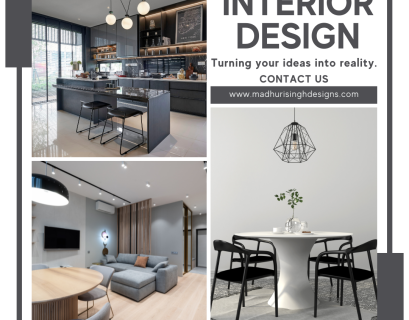1. Why Texture Matters in Interior Design
Texture adds a tactile and visual quality to interior design, creating depth and dimension that goes beyond color and pattern. It gives a room character, making spaces feel either more relaxed or more formal, depending on the materials chosen. The feel of a surface—whether smooth, rough, soft, or hard—directly influences the ambiance of a room and how it resonates emotionally with those who occupy it.
Top designers from interior design firms in Delhi and Noida often incorporate textures to add sophistication and uniqueness to a space. For example, a plush velvet sofa can instantly elevate a room’s coziness, while sleek marble countertops lend a sense of luxury. Balancing different textures within a room creates visual interest and an inviting, multidimensional effect.
2. Types of Textures and Their Effects
Using texture skillfully requires understanding the types available and the effects they create. Here are some common textures that top interior designers incorporate to bring out the best in each space:
- Smooth Textures: These reflect light and create a polished, clean look. Surfaces like glass, mirrors, and metals are perfect for modern and minimalist styles.
- Rough Textures: Rough or matte surfaces absorb light, creating a cozy and intimate atmosphere. Materials like wood, stone, and brick are often used for this effect, giving spaces a warm, rustic feel.
- Soft Textures: Fabrics such as velvet, wool, and cotton add a sense of comfort and luxury. Designers often layer soft textures in spaces meant for relaxation, like bedrooms and living rooms, for a cozy appeal.
- Patterned Textures: Patterns on wallpapers, rugs, and upholstery introduce texture and add depth to a space without needing three-dimensional materials.
A balance of these types enhances the visual hierarchy, so different elements do not compete but rather complement one another.
3. The Role of Layering in Texture
Layering textures is one of the most effective techniques for creating a cohesive and visually interesting room. Imagine walking into a room with smooth walls, a plush velvet sofa, a shaggy rug, and a textured throw—all these elements together create a balanced yet visually appealing design.
Designers from an interior design company in Delhi or Noida frequently use layering to combine various textures. For instance, pairing a leather chair with a soft wool blanket or mixing smooth metal frames with textured wooden tables adds contrast and richness to the room. This approach makes spaces look thoughtfully curated rather than hastily designed.
4. Balancing Warm and Cool Textures
Textures can convey warmth or coolness depending on their material. Warm textures, such as wood or fabric, create a cozy, inviting environment, while cool textures, like metal or glass, contribute to a modern, airy feel. The best designers know how to balance these textures according to the purpose of the room. For instance, a living room might benefit from more warm textures, while a kitchen could have a mix, combining cool marble countertops with warm wooden cabinets for balance.
By mixing warm and cool textures, designers also avoid creating a monotone effect, which can make rooms feel lifeless. Instead, a balanced interplay of textures will draw attention to various parts of the room, guiding the eye seamlessly.
5. Texture and Color: The Perfect Combination
Color and texture are intertwined in design. Textures often affect the way colors appear, influencing the depth and shade perceived by the viewer. For example, a rough-textured paint on a wall will make colors appear more muted and rustic, whereas a high-gloss finish can make colors look vibrant and polished.
Top designers, including the best interior designer in Noida, carefully consider the color palette along with textures to achieve the desired mood. Dark, matte textures often look more dramatic, while light, smooth surfaces appear bright and energizing. This thoughtful coordination ensures that colors do not overwhelm the room but instead enhance the texture and design of each element.
6. Texture and Lighting: Setting the Mood
Texture plays a vital role in how light interacts with a room. Rough textures diffuse light and create a soft, inviting glow, perfect for intimate spaces. Smooth textures, on the other hand, reflect light, enhancing brightness and making spaces feel more expansive.
When working with an interior design company in Delhi, they can help plan lighting based on texture for an enhanced effect. Strategically placed lights can highlight the contrast between textures, creating focal points in the room. For example, illuminating a brick wall will bring out its rough texture, adding character and a dramatic effect to the space.
7. Common Mistakes to Avoid with Texture
While texture is powerful, misusing it can lead to a cluttered and disjointed look. Here are common mistakes to avoid:
- Overdoing Patterns: Too many patterned textures can create a busy and overwhelming atmosphere. Aim for a mix of patterns and solids to balance the visual flow.
- Ignoring Room Purpose: Think about the room’s function when choosing textures. Softer textures suit relaxed areas like bedrooms, while durable, easy-to-clean surfaces are better for high-traffic areas like kitchens.
- Lack of Contrast: A room without contrast in textures may appear flat. Mix different textures (e.g., a soft rug with a hard coffee table) to bring depth to the design.
By sidestepping these mistakes, you’ll achieve a more balanced and harmonious look that resonates with the overall design concept.
8. Tips for Incorporating Texture in Small Spaces
If you’re working with a smaller space, using textures can be tricky but rewarding. The key is moderation. Stick to a few high-impact textures and avoid over-cluttering. Here are some tips:
- Use Mirrors and Glass: These materials add smoothness and help light bounce around the room, creating a more open feel.
- Opt for Lightweight Fabrics: Choose light, airy fabrics for small spaces, like linen or cotton, which add texture without overwhelming.
- Feature Walls: A single wall with exposed brick or textured wallpaper adds depth without overcrowding the space.
Conclusion
Textures are transformative in interior design. With the right mix, textures enhance not only the look of a room but its feel and mood. Whether you’re designing a cozy bedroom or a modern kitchen, working with an experienced interior design company in Delhi or consulting with the best interior designer in Noida can bring professional insights and guidance in texture usage, making a significant difference in the outcome of your space. By embracing texture, you add layers of depth, elegance, and personality, ensuring your interiors are visually engaging and welcoming.


















